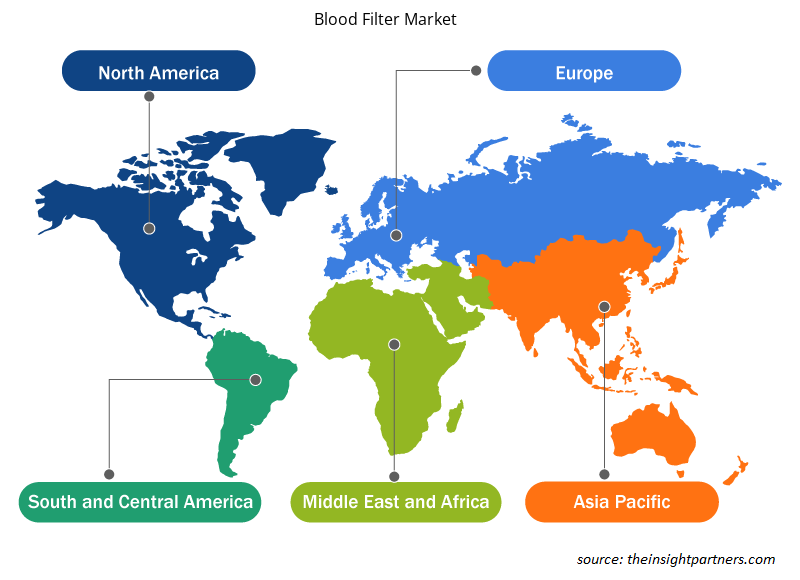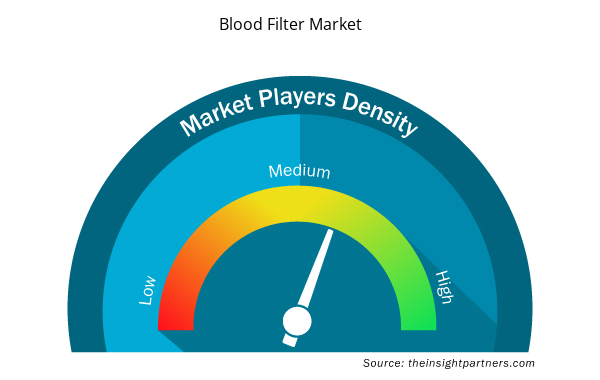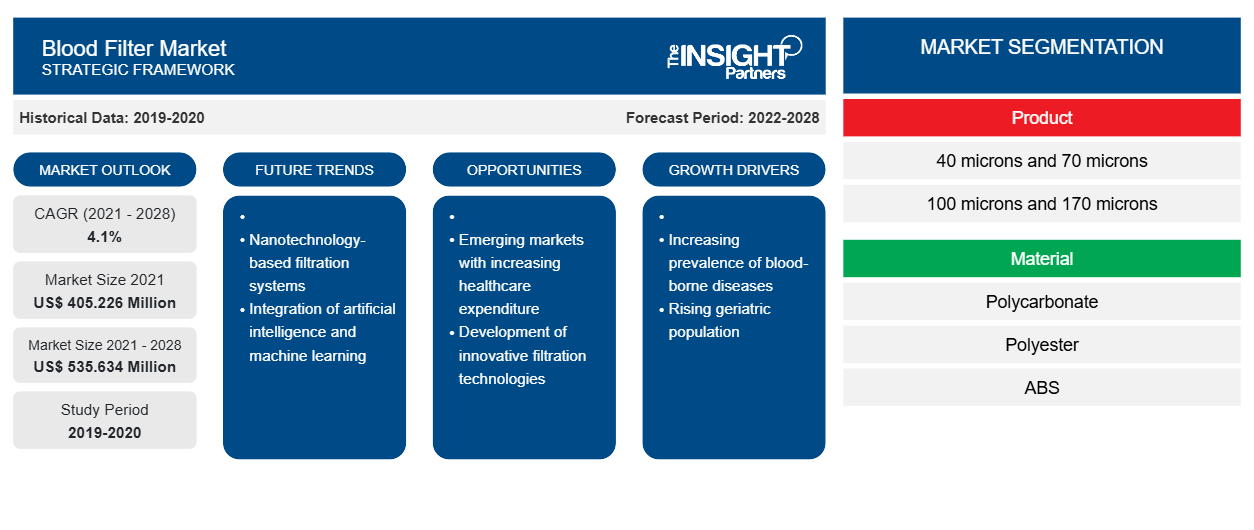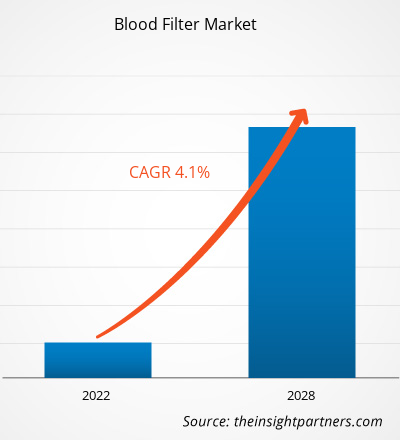血液フィルター市場は、2021年の4億522万6000米ドルから2028年には5億3563万4000米ドルに達すると予測されており、 2021年から2028年にかけて4.1%のCAGRで成長すると推定されています。
血液フィルターは、ポリエステルまたはナイロン製の織りメッシュで構成されたスクリーンタイプのフィルターで、製品バッグと患者の間に配置され、濾過を行います。これらのフィルターは、血流に入ると危険なマクロ凝集体や非血液成分の粒子状物質から患者を保護することを目的としています。輸血中に、ミクロ凝集体部位やフィブリン凝集体などのマクロ凝集体を除去します。濾過には、血液の保存中に形成された白血球、フィブリン、血小板から作られた粒子やマクロ凝集体を捕捉することが含まれます。慢性疾患の負担の増加、外傷や事故の急増、輸血処置の数の増加などの要因が、血液フィルター市場の成長を牽引しています。ただし、製品リコールが市場の成長を妨げています。
要件に合わせてレポートをカスタマイズする
このレポートの一部、国レベルの分析、Excelデータパックなど、あらゆるレポートを無料でカスタマイズできます。また、スタートアップや大学向けのお得なオファーや割引もご利用いただけます。
- このレポートの主要な市場動向を入手してください。この無料サンプルには、市場動向から見積もりや予測に至るまでのデータ分析が含まれます。
市場分析
輸血処置の増加が血液フィルター市場の成長を後押し
輸血処置のための安全で十分な血液の供給を改善することは、各国の国家医療政策とインフラの不可欠な部分であるべきです。輸血の必要性は、都市部でも農村部でもいつでも発生する可能性があります。過去には、血液の供給不足により、健康を害した多くの患者が死亡しました。安全な血液を十分に確実に供給するには、定期的な自発的かつ無償の献血者のための安定した施設が必要です。献血者は血液媒介感染症の罹患率が最も低いため、最も安全な献血者グループでもあります。
輸血を必要とする最も一般的な手術には、心血管手術、帝王切開手術、および外傷が含まれます。国立心肺血液研究所と国立衛生研究所(NIH)の推定によると、米国では毎年500万人以上が輸血を必要としています。さらに、自然災害と広範囲にわたる死傷者により、輸血の需要は世界中で増加しています。貧血、赤血球増多症、白血球増多症、白血球減少症、血小板増多症などの血液疾患の発生率の急増も、血液フィルター市場の成長を後押ししています。WHOによると、サラセミアの子供のほとんどは低所得国で生まれており、輸血を受けることが困難であるか、人口のごく一部しか利用できません。
輸血処置で使用される血液フィルターは、ポリエステルまたはナイロン製の織りメッシュで、製品バッグと患者の間に配置されるスクリーンタイプのフィルターです。これらのフィルターは、血小板、白血球、フィブリンタンパク質、および非血液成分の粒子状物質などの潜在的に有害なマクロ凝集体から患者を保護するように設計されています。先進国の大多数では、輸血フィルターは政府またはコミュニティベースのプログラムによって提供されています。したがって、献血に適した施設と自発的な献血者が利用できることで、輸血処置の数が増加し、血液充填剤市場の成長が促進されます。
製品ベースの洞察
製品に基づいて、血液フィルター市場はさらに40ミクロンと70ミクロン、100ミクロンと170ミクロン、その他に細分化されています。100ミクロンと170ミクロンのセグメントは2021年に最大の市場シェアを占め、予測期間中に高いCAGRを記録すると予想されます。
材料ベースの洞察
材質別に見ると、血液フィルター市場はポリカーボネート、ポリエステル、ABS、その他に分類されます。ポリエステルセグメントは2021年に35.47%の最大の市場シェアを占め、予測期間中もその優位性を維持すると予想されます。
アプリケーションベースの洞察
用途に基づいて、血液フィルター市場は血液処理と輸血に分かれています。輸血セグメントは2021年に73.83%の最大の市場シェアを占め、予測期間中もその優位性を維持すると予想されます。
エンドユーザーベースの洞察
エンドユーザーに基づいて、血液フィルター市場は血液銀行、病院、その他に分類されます。血液銀行セグメントは2021年に47.38%の最大の市場シェアを占め、予測期間中もその優位性を維持すると予想されます。
血液フィルター市場で事業を展開するさまざまな企業は、製品の発売、合併や買収、コラボレーション、製品の革新、製品ポートフォリオの拡大などの戦略を採用して、世界中で事業を拡大し、ブランド名を維持し、エンドユーザーからの高まる需要に応えています。
血液フィルター市場の地域別分析
予測期間を通じて血液フィルター市場に影響を与える地域的な傾向と要因は、Insight Partners のアナリストによって徹底的に説明されています。このセクションでは、北米、ヨーロッパ、アジア太平洋、中東、アフリカ、南米、中米にわたる血液フィルター市場のセグメントと地理についても説明します。

- 血液フィルター市場の地域別データを入手
血液フィルター市場レポートの範囲
| レポート属性 | 詳細 |
|---|---|
| 2021年の市場規模 | 4億522万6千米ドル |
| 2028年までの市場規模 | 5億3,563万4,000米ドル |
| 世界のCAGR(2021年~2028年) | 4.1% |
| 履歴データ | 2019-2020 |
| 予測期間 | 2022-2028 |
| 対象セグメント | 製品別
|
| 対象地域と国 | 北米
|
| 市場リーダーと主要企業プロフィール |
|
血液フィルター市場のプレーヤー密度:ビジネスダイナミクスへの影響を理解する
血液フィルター市場は、消費者の嗜好の変化、技術の進歩、製品の利点に対する認識の高まりなどの要因により、エンドユーザーの需要が高まり、急速に成長しています。需要が高まるにつれて、企業は提供品を拡大し、消費者のニーズを満たすために革新し、新たなトレンドを活用し、市場の成長をさらに促進しています。
市場プレーヤー密度とは、特定の市場または業界内で活動している企業または会社の分布を指します。これは、特定の市場スペースに、その規模または総市場価値と比較して、どれだけの競合相手 (市場プレーヤー) が存在するかを示します。
血液フィルター市場で事業を展開している主要企業は次のとおりです。
- 旭化成株式会社
- フレゼニウス カビ AG
- マコファーマ
- ヘモネティクスコーポレーション
- インフォメッドSA
免責事項:上記の企業は、特定の順序でランク付けされていません。

- 血液フィルター市場のトップキープレーヤーの概要を入手
血液フィルター市場 – 製品別
- 40ミクロンと70ミクロン
- 100ミクロンと170ミクロン
- その他
血液フィルター市場 – 材質別
- ポリカーボネート
- ポリエステル
- アブソリュート
- その他
血液フィルター市場 – 用途別
- 血液処理
- 輸血
血液フィルター市場 – エンドユーザー別
- 血液銀行
- 病院
- その他
血液フィルター市場 – 地域別
- 北米
- 私たち
- カナダ
- メキシコ
- ヨーロッパ
- フランス
- ドイツ
- イタリア
- 英国
- スペイン
- その他のヨーロッパ
- アジア太平洋(APAC)
- 中国
- インド
- 韓国
- 日本
- オーストラリア
- その他のアジア太平洋地域
- 中東・アフリカ(MEA)
- 南アフリカ
- サウジアラビア
- アラブ首長国連邦
- その他の中東およびアフリカ
- 南米および中米(詐欺)
- ブラジル
- アルゼンチン
- 南米および中米のその他の地域
企業プロフィール
- 旭化成株式会社
- フレゼニウス カビ AG
- マコファーマ
- ヘモネティクスコーポレーション
- インフォメッドSA
- 株式会社カネカ
- 株式会社川澄化学研究所
- セファールAG
- 山東中宝康医療器具有限公司
- 南京双偉生物技術有限公司
- 過去2年間の分析、基準年、CAGRによる予測(7年間)
- PEST分析とSWOT分析
- 市場規模価値/数量 - 世界、地域、国
- 業界と競争環境
- Excel データセット


- Smart Parking Market
- Public Key Infrastructure Market
- Small Satellite Market
- Dealer Management System Market
- Small Internal Combustion Engine Market
- Skin Graft Market
- Batter and Breader Premixes Market
- Electronic Signature Software Market
- Malaria Treatment Market
- Redistribution Layer Material Market

Report Coverage
Revenue forecast, Company Analysis, Industry landscape, Growth factors, and Trends

Segment Covered
This text is related
to segments covered.

Regional Scope
North America, Europe, Asia Pacific, Middle East & Africa, South & Central America

Country Scope
This text is related
to country scope.
よくある質問
Global blood filter market is segmented by region into North America, Europe, Asia Pacific, Middle East & Africa, and South & Central America. In North America, The US holds the largest size of the market in this region. Nearly 16 million blood components are transfused each year in the U.S. According to the American Cancer Society, more than 1.8 million people are expected to be diagnosed with cancer in 2020. Many of them will need blood, sometimes daily, during their chemotherapy treatment. Blood products are transfused through intravenous tubing with filters. The filters, which typically have pore diameters of 170 to 260 microns, are used to prevent particulate debris from being administered as well. The trapped material promotes bacterial growth, and the American Association of Blood Banks (AABB) recommends not using a filter for more than 4 hours. The government is also experiencing increasing chronic conditions such as acute kidney injury (AKI), multiple organ dysfunction syndromes, or sepsis. Thus, it is expected that rising incidences of chronic diseases are likely to influence the market's growth. Moreover, the rise in transplant procedures across the United States is expected to increase the blood transfer procedures that require collection units such as tubes, bags, and others. According to the Red Cross Blood Center, 4.5 million Americans require blood transfusion annually.
The blood filter market majorly consists of players such Asahi Kasei Corporation, Fresenius Kabi AG, Macopharma, Haemonetics Corporation, Infomed SA, KANEKA CORPORATION, Kawasumi laboratories. Inc., Sefar AG, Shandong Zhongbaokang Medical Implements Co., Ltd, Nanjing Shuangwei Biotechnology Co., Ltd. among others.
The blood transfusion segment dominated the global blood filter market and accounted for the largest revenue share of 73.83% in 2021
The blood banks segment dominated the global colon blood filter market and accounted for the largest revenue share of 47.38% in 2021.
A blood filter is a screen-type filter composed of woven mesh made from polyester or nylon, and it is placed between the product bag and the patient for performing filtration. These filters are intended to protect patients from macro-aggregates and non-blood component particulate matter that could be hazardous if enter the bloodstream. They remove macro-aggregates such as micro-aggregate sites and fibrin aggregates during a blood transfusion. Filtration involves capturing particles and macro-aggregates made from leucocytes, fibrin, and platelets, formed during blood storage.
Key factors that are driving the growth of this market are an increase in the burden of chronic diseases, a surge in cases of trauma and accidents, and a rising number of blood transfusion procedures are expected to boost the market growth for the blood filter over the years.
The 100micron and 170-micron segment dominated the global blood filter market and held the largest revenue share of 56.80% in 2021.
The polyester segment dominated the global blood filter market and held the largest revenue share of 35.47% in 2021.
Trends and growth analysis reports related to Life Sciences : READ MORE..
The List of Companies - Blood Filter Market
- Asahi Kasei Corporation
- Fresenius Kabi AG
- Macopharma
- Haemonetics Corporation
- Infomed SA
- KANEKA CORPORATION
- Kawasumi laboratories. Inc.
- Sefar AG
- Shandong Zhongbaokang Medical Implements Co., Ltd.
- Nanjing Shuangwei Biotechnology Co., Ltd.
The Insight Partners performs research in 4 major stages: Data Collection & Secondary Research, Primary Research, Data Analysis and Data Triangulation & Final Review.
- Data Collection and Secondary Research:
As a market research and consulting firm operating from a decade, we have published and advised several client across the globe. First step for any study will start with an assessment of currently available data and insights from existing reports. Further, historical and current market information is collected from Investor Presentations, Annual Reports, SEC Filings, etc., and other information related to company’s performance and market positioning are gathered from Paid Databases (Factiva, Hoovers, and Reuters) and various other publications available in public domain.
Several associations trade associates, technical forums, institutes, societies and organization are accessed to gain technical as well as market related insights through their publications such as research papers, blogs and press releases related to the studies are referred to get cues about the market. Further, white papers, journals, magazines, and other news articles published in last 3 years are scrutinized and analyzed to understand the current market trends.
- Primary Research:
The primarily interview analysis comprise of data obtained from industry participants interview and answers to survey questions gathered by in-house primary team.
For primary research, interviews are conducted with industry experts/CEOs/Marketing Managers/VPs/Subject Matter Experts from both demand and supply side to get a 360-degree view of the market. The primary team conducts several interviews based on the complexity of the markets to understand the various market trends and dynamics which makes research more credible and precise.
A typical research interview fulfils the following functions:
- Provides first-hand information on the market size, market trends, growth trends, competitive landscape, and outlook
- Validates and strengthens in-house secondary research findings
- Develops the analysis team’s expertise and market understanding
Primary research involves email interactions and telephone interviews for each market, category, segment, and sub-segment across geographies. The participants who typically take part in such a process include, but are not limited to:
- Industry participants: VPs, business development managers, market intelligence managers and national sales managers
- Outside experts: Valuation experts, research analysts and key opinion leaders specializing in the electronics and semiconductor industry.
Below is the breakup of our primary respondents by company, designation, and region:

Once we receive the confirmation from primary research sources or primary respondents, we finalize the base year market estimation and forecast the data as per the macroeconomic and microeconomic factors assessed during data collection.
- Data Analysis:
Once data is validated through both secondary as well as primary respondents, we finalize the market estimations by hypothesis formulation and factor analysis at regional and country level.
- Macro-Economic Factor Analysis:
We analyse macroeconomic indicators such the gross domestic product (GDP), increase in the demand for goods and services across industries, technological advancement, regional economic growth, governmental policies, the influence of COVID-19, PEST analysis, and other aspects. This analysis aids in setting benchmarks for various nations/regions and approximating market splits. Additionally, the general trend of the aforementioned components aid in determining the market's development possibilities.
- Country Level Data:
Various factors that are especially aligned to the country are taken into account to determine the market size for a certain area and country, including the presence of vendors, such as headquarters and offices, the country's GDP, demand patterns, and industry growth. To comprehend the market dynamics for the nation, a number of growth variables, inhibitors, application areas, and current market trends are researched. The aforementioned elements aid in determining the country's overall market's growth potential.
- Company Profile:
The “Table of Contents” is formulated by listing and analyzing more than 25 - 30 companies operating in the market ecosystem across geographies. However, we profile only 10 companies as a standard practice in our syndicate reports. These 10 companies comprise leading, emerging, and regional players. Nonetheless, our analysis is not restricted to the 10 listed companies, we also analyze other companies present in the market to develop a holistic view and understand the prevailing trends. The “Company Profiles” section in the report covers key facts, business description, products & services, financial information, SWOT analysis, and key developments. The financial information presented is extracted from the annual reports and official documents of the publicly listed companies. Upon collecting the information for the sections of respective companies, we verify them via various primary sources and then compile the data in respective company profiles. The company level information helps us in deriving the base number as well as in forecasting the market size.
- Developing Base Number:
Aggregation of sales statistics (2020-2022) and macro-economic factor, and other secondary and primary research insights are utilized to arrive at base number and related market shares for 2022. The data gaps are identified in this step and relevant market data is analyzed, collected from paid primary interviews or databases. On finalizing the base year market size, forecasts are developed on the basis of macro-economic, industry and market growth factors and company level analysis.
- Data Triangulation and Final Review:
The market findings and base year market size calculations are validated from supply as well as demand side. Demand side validations are based on macro-economic factor analysis and benchmarks for respective regions and countries. In case of supply side validations, revenues of major companies are estimated (in case not available) based on industry benchmark, approximate number of employees, product portfolio, and primary interviews revenues are gathered. Further revenue from target product/service segment is assessed to avoid overshooting of market statistics. In case of heavy deviations between supply and demand side values, all thes steps are repeated to achieve synchronization.
We follow an iterative model, wherein we share our research findings with Subject Matter Experts (SME’s) and Key Opinion Leaders (KOLs) until consensus view of the market is not formulated – this model negates any drastic deviation in the opinions of experts. Only validated and universally acceptable research findings are quoted in our reports.
We have important check points that we use to validate our research findings – which we call – data triangulation, where we validate the information, we generate from secondary sources with primary interviews and then we re-validate with our internal data bases and Subject matter experts. This comprehensive model enables us to deliver high quality, reliable data in shortest possible time.


 このレポートの無料サンプルを入手する
このレポートの無料サンプルを入手する